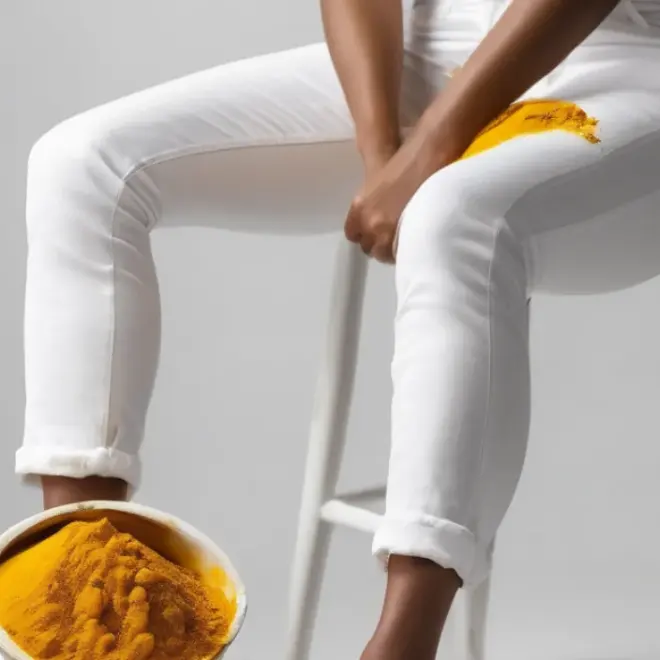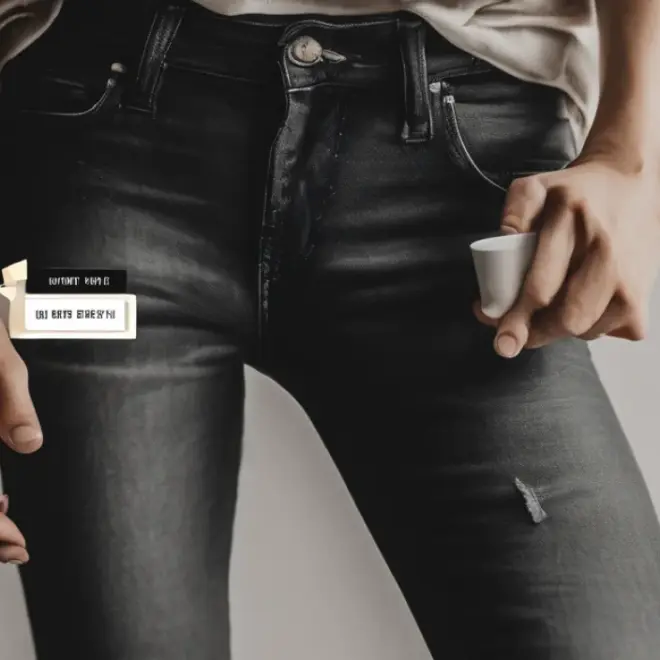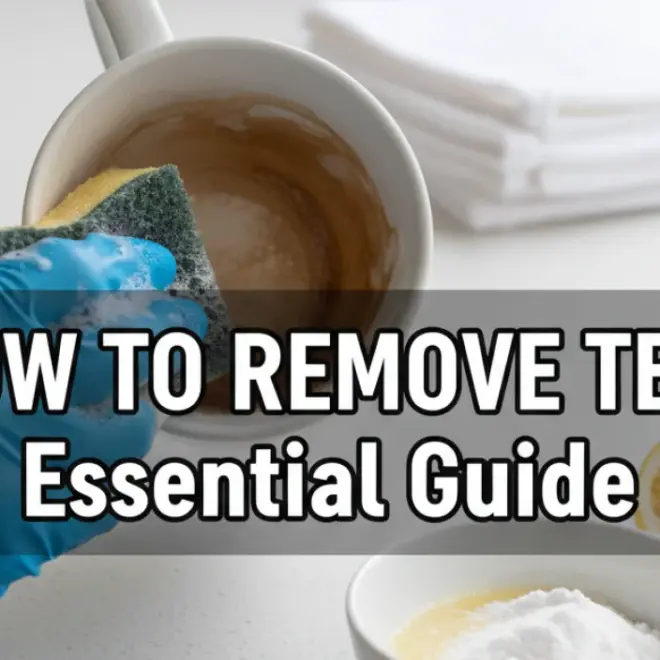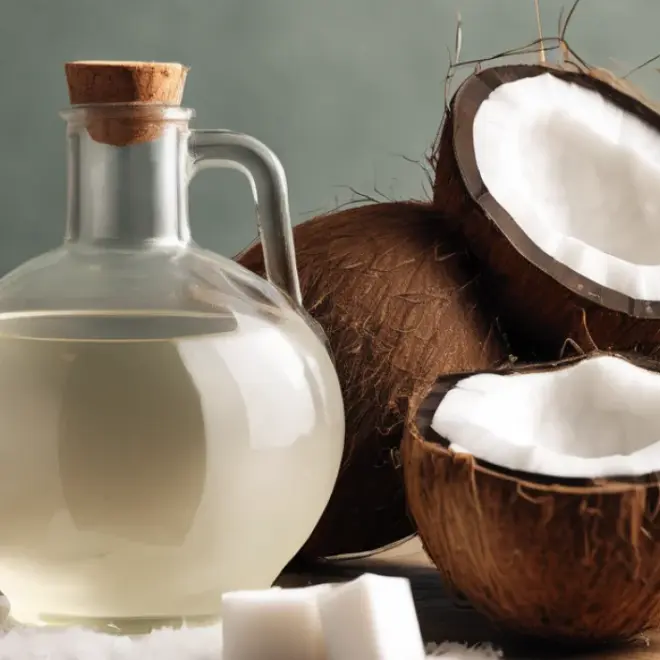Quick Summary: To remove spray paint from jeans, act fast! Start with a gentle solvent like rubbing alcohol or a specialized stain remover, followed by a thorough wash. For tougher spots, denim-friendly removers or even DIY paste might be needed. Patience and the right approach can save your favorite denim.
Accidents happen, and sometimes that means a stray can of spray paint finds its way onto your favorite pair of jeans. It’s a frustrating sight, but don’t despair! This common issue doesn’t have to mean the end of your denim. With the right knowledge and a few simple household items, you can often rescue your jeans and make those paint splatters disappear.
This guide will walk you through effective methods, from the gentlest approaches for fresh stains to more robust solutions for dried-on paint. We’ll cover what you need, step-by-step processes, and some handy tips to ensure you get the best results. Let’s get your jeans looking good as new!
Understanding Spray Paint on Denim
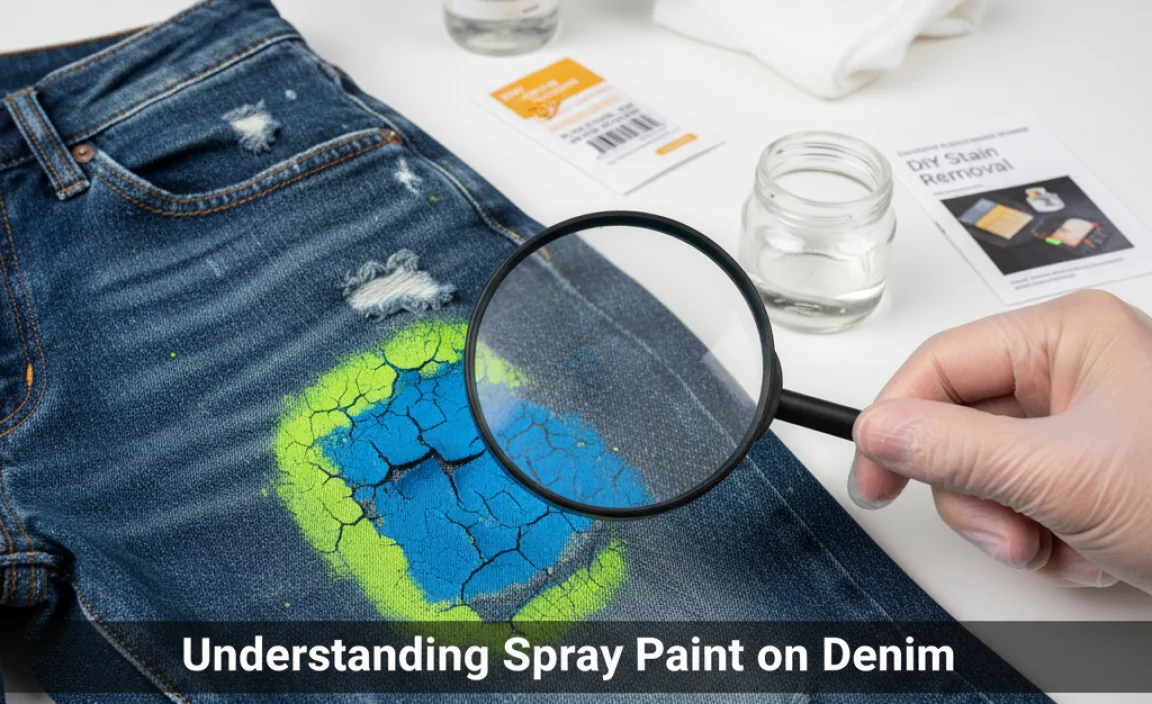
Spray paint is designed to adhere strongly to surfaces, which is great for art projects but less so when it lands on your clothing. The effectiveness of removal depends heavily on a few factors:
- Type of Paint: Water-based latex paints are generally easier to remove than oil-based or enamel paints.
- Age of the Stain: Fresh paint is significantly easier to lift than paint that has cured and bonded with the fabric fibers.
- Denim Type: While most methods work on standard denim, very delicate or specialty washes might require extra care.
The goal is to break down the paint without damaging the denim’s color or fabric. This usually involves using a solvent or a cleaning agent that can dissolve the paint’s binder, allowing it to be washed away.
Essential Tools for Spray Paint Removal
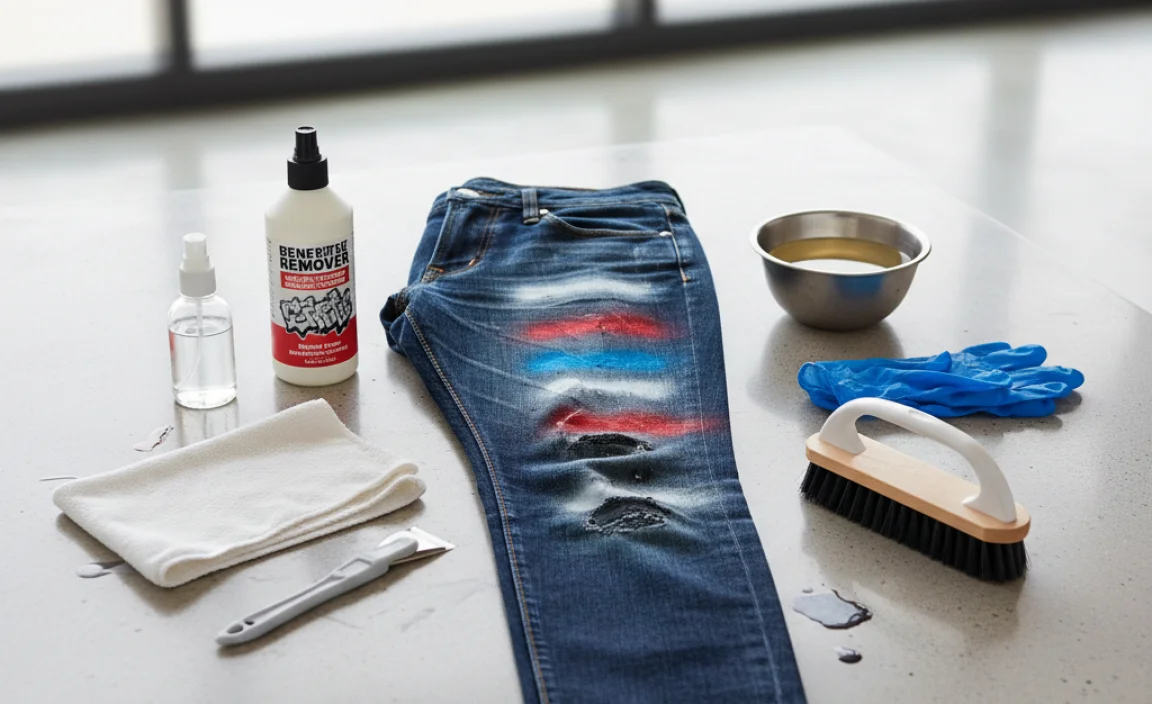
Before you start, gather these common items:
- Gloves: To protect your hands from solvents.
- Clean cloths or paper towels: For blotting and scrubbing.
- Rubbing alcohol (Isopropyl alcohol): A versatile solvent for fresh paint.
- Dish soap: Good for pre-treating and general cleaning.
- Laundry detergent: For the final wash.
- A soft-bristled brush or old toothbrush: For gentle scrubbing.
- Spray paint removers (optional): Specialized products designed for fabric.
- Nail polish remover (acetone-based, use with caution): For stubborn, dried paint.
- Baking soda (optional): Can be used in a paste.
- WD-40 (use with caution, test first): Another potential solver for tough stains.
Always test any cleaning solution on an inconspicuous area of the jeans first, such as an inside seam or hem, to ensure it doesn’t discolor or damage the fabric.
Method 1: For Fresh, Wet Spray Paint
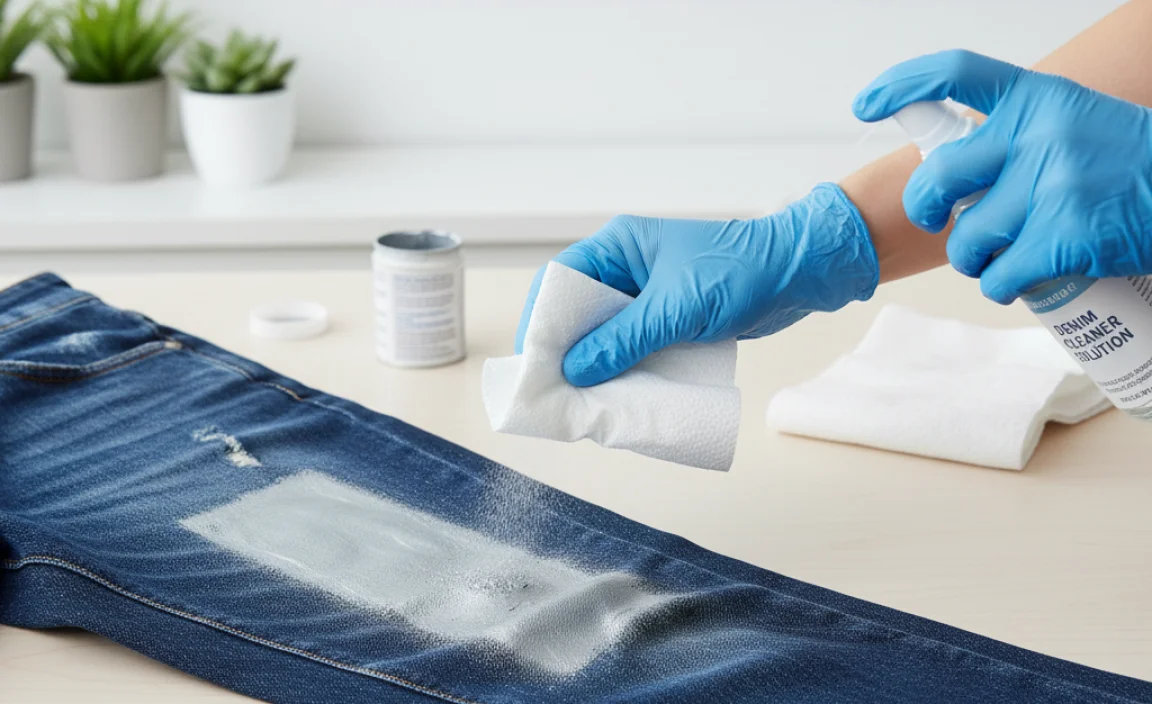
If you catch the spray paint right after it happens, you’re in luck! Speed is your best friend here.
Step-by-Step Guide:
- Blot Immediately: Do not rub. Gently blot up as much of the wet paint as possible with a clean cloth or paper towel. Work from the outside of the stain inwards to prevent spreading.
- Apply Rubbing Alcohol: Dampen a clean cloth with rubbing alcohol. Gently blot the stained area. You should see the paint start to transfer onto the cloth. Keep using clean sections of the cloth until no more paint is lifting.
- Rinse with Cold Water: Once you’ve removed as much as possible, rinse the area thoroughly with cold water to wash away residual alcohol and loosened paint.
- Pre-treat with Dish Soap: Apply a small amount of liquid dish soap directly to the remaining stain and gently rub it in with your fingers or a soft brush. Let it sit for 5-10 minutes.
- Wash as Usual: Launder the jeans in cold water with your regular detergent.
- Air Dry: Do NOT put the jeans in the dryer until you are absolutely sure the stain is gone. Heat can set any remaining paint, making it permanent. Inspect the area once dry. If the stain persists, repeat the process or move to a method for dried paint.
Rubbing alcohol is a fantastic first line of defense because it’s a mild solvent that effectively breaks down many types of wet paint without being overly harsh on fabric.
Method 2: For Dried-On Spray Paint
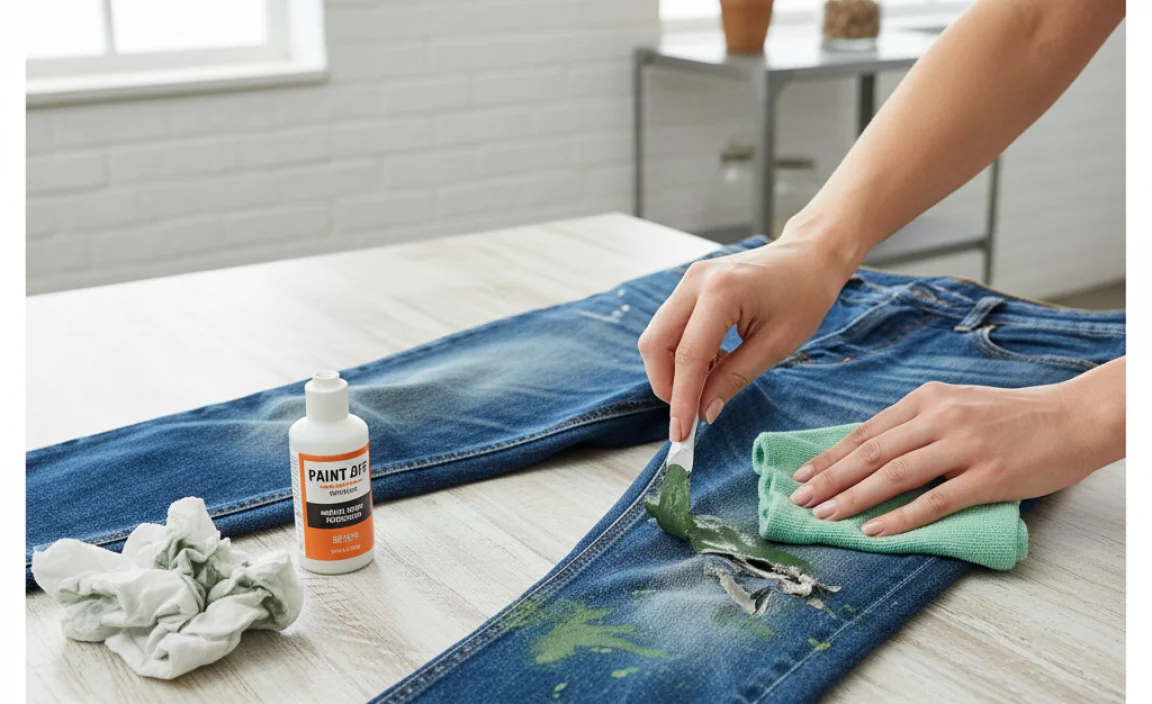
Dried spray paint can be more challenging, but it’s often still removable with a bit more effort.
Step-by-Step Guide:
- Scrape Off Excess: If there are thick, dried globs of paint, try to gently scrape them off with a dull knife or the edge of a credit card. Be careful not to damage the denim fibers.
- Choose Your Solvent: For dried paint, you might need a stronger approach. Options include:
- Rubbing Alcohol: Still a good option, but you may need to let it soak longer.
- Denim-Specific Stain Remover: Products like Goo Gone or Ja-Ru.com’s Stain & Odor Remover are formulated for tough stains.
- Acetone-based Nail Polish Remover: Use this sparingly as it can be strong.
- WD-40: Can work on oil-based paints but requires thorough washing afterward to remove its own residue.
- Test the Solvent: Always test your chosen solvent on an inside seam or hem first.
- Apply the Solvent: Apply your chosen solvent to a clean cloth. Gently dab and rub the dried paint stain. You may need to let it sit for a few minutes to soften the paint.
- Work the Stain: Use a soft-bristled brush or an old toothbrush to gently scrub the softened paint. Work in small sections.
- Rinse and Repeat: Rinse the treated area with cold water. If the paint is still present, repeat the solvent application and scrubbing.
- Pre-treat and Wash: Once the paint is significantly lightened or gone, apply a pre-treatment stain remover or a good amount of liquid dish soap to the area. Let it sit, then wash the jeans in cold water with heavy-duty detergent.
- Inspect and Air Dry: Check carefully for any remaining paint. If the stain is gone, air dry the jeans. If any residue remains, do not machine dry it, as heat will set it permanently. You may need to try a different solvent or repeat the process.
Specialized Commercial Removers
Products specifically designed to remove paint from fabric are often very effective. These are formulated to break down paint without causing undue harm to most textiles. Always follow the manufacturer’s instructions carefully when using commercial removers.
For more information on fabric care and stain removal, the Federal Trade Commission offers general tips on clothing care and consumer advice.
Method 3: DIY Pastes for Stubborn Stains
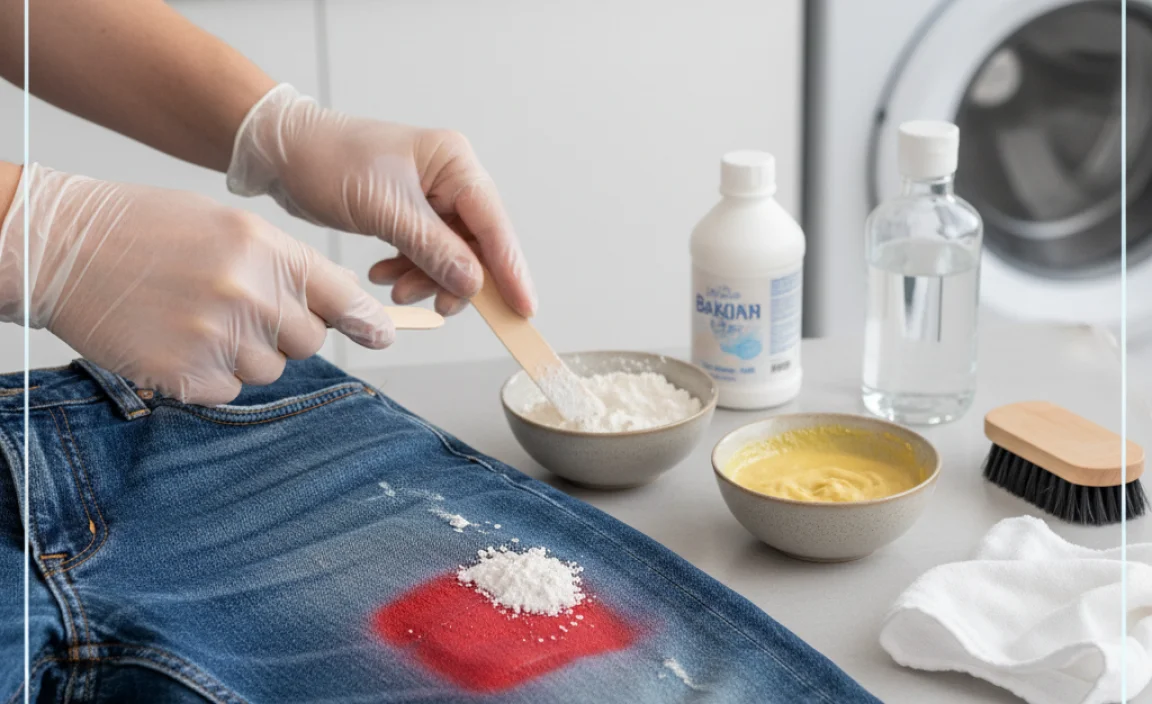
For very stubborn, set-in stains, a DIY paste can sometimes work wonders. These are often made with common household ingredients.
Baking Soda and Water Paste
- Create the Paste: Mix baking soda with a small amount of water to form a thick paste.
- Apply to Stain: Apply the paste generously to the dried paint stain.
- Let it Sit: Allow the paste to sit on the stain for at least 30 minutes, or longer for tough stains.
- Scrub Gently: Use a soft brush to gently scrub the paste into the stain.
- Rinse and Wash: Rinse the area thoroughly with cold water. If the stain has lifted, proceed to pre-treat with dish soap and wash the jeans as usual. Repeat if necessary.
Baking Soda and Dish Soap Paste
- Mix Ingredients: Combine equal parts baking soda and liquid dish soap.
- Apply and Rub: Apply this paste to the dried spray paint stain and gently rub it in.
- Soak (Optional): For tough stains, you can let the paste sit for an hour or so.
- Scrub and Wash: Gently scrub with a brush, then rinse. Pre-treat with more dish soap and wash the jeans in cold water.
These pastes work by providing a mild abrasive action (baking soda) combined with the cleaning power of soap or water, which can help lift and break down the paint over time.
Understanding Different Paint Types and Their Removal
The strategy for removing spray paint often needs to be tailored to the type of paint.
| Paint Type | Characteristics | Best Removal Methods (Fresh) | Best Removal Methods (Dried) | Considerations |
|---|---|---|---|---|
| Water-Based (Latex/Acrylic) | Cleans up with water when wet. Dries to a more durable finish. | Water, Dish Soap, Rubbing Alcohol | Rubbing Alcohol, Denatured Alcohol (Popular Mechanics on cleaning solvents) | Generally easier to remove. |
| Oil-Based/Enamel | Requires mineral spirits or paint thinner for cleanup when wet. Becomes very hard when dry. | Mineral Spirits (test first!), WD-40, Rubbing Alcohol (less effective) | Mineral Spirits, Acetone, Specialized Paint Removers, Scraping | More difficult; may require stronger solvents and multiple treatments. Test solvents very carefully. |
| Lacquer | Dries very quickly to a hard finish. | Lacquer Thinner, Acetone | Lacquer Thinner, Acetone | Extremely strong solvents. High risk of fabric damage; extreme caution and testing are essential. |
Always be mindful of the specific type of spray paint if you know it, as this can significantly guide your approach and prevent unnecessary damage to your jeans. If the paint can doesn’t specify, start with the gentlest methods that are likely to work on water-based paints.
Tips for Protecting Your Jeans During Cleaning
While removing paint, it’s important to preserve the integrity of your jeans:
- Gentle Scrubbing: Never use harsh scrubbing pads or wire brushes, as these will damage the denim fibers and potentially create holes or uneven wear. A soft toothbrush or a clean cloth is best.
- Work from the Back: For some stains, especially if they’ve soaked through, you can try applying the solvent from the underside of the fabric and dabbing the top. This can help push the stain out rather than deeper in.
- Rinse Thoroughly: Ensure all cleaning agents are completely rinsed from the fabric before washing and drying. Residue can sometimes lead to discoloration or weaken the fabric over time.
- Patience is Key: Stubborn stains, especially dried oil-based paints, may require multiple applications and treatments. Don’t rush the process, and avoid aggressive scrubbing that could damage the material.
- Consider the Fabric Weave: Denim is a sturdy fabric, but very distressed or lightweight denim might not withstand strong solvents or vigorous scrubbing as well as standard, heavier denim. Always test first.
When to Seek Professional Help
If your jeans are particularly valuable, made of delicate material, or if the stain is extensive and has set deeply, you might consider taking them to a professional dry cleaner. Explain the situation clearly so they can use their expertise and specialized cleaning agents to attempt removal without damaging the garment.
However, for most common denim and spray paint scenarios, the home-based methods outlined in this guide should be sufficient.
Frequently Asked Questions (FAQ)
Q1: Will rubbing alcohol ruin my jeans?
A: Rubbing alcohol is generally safe for most denim when used as directed. It’s a mild solvent. However, always test it on an inconspicuous area first (like an inside seam) to ensure it doesn’t affect the dye of your specific jeans.
Q2: Is it better to treat wet or dried spray paint?
A: It’s significantly easier to remove wet spray paint. If you spill fresh paint on your jeans, act immediately by blotting up excess and then treating with a solvent like rubbing alcohol. Dried paint is much harder to remove and often requires stronger methods.
Q3: Can I use nail polish remover on my jeans?
A: You can, but use it with extreme caution. Acetone-based nail polish remover is a strong solvent that can effectively break down dried paint. However, it can also lift the dye from your jeans or damage certain fabric finishes. Always test it on a hidden area first, and use it sparingly.
Q4: What’s the best way to wash jeans after using a strong solvent?
A: After treating a stain with a solvent like rubbing alcohol or mineral spirits, rinse the area very well with cold water. Then, wash the jeans in cold water with a good quality laundry detergent. Avoid using bleach, as it can interact negatively with residual cleaning agents or damage the denim.
Q5: My jeans went through the dryer, and the paint stain is still there. Is it permanent?
A: Once a paint stain has been exposed to the heat of a dryer, it’s much more likely to have permanently bonded with the fabric fibers. While it’s worth attempting some of the stronger removal methods, the chances of complete removal significantly decrease after heat setting.
Q6: How can I prevent spray paint stains on my jeans in the future?
A: Always wear old clothes or an apron when working with spray paint. If you must wear good jeans, consider covering them with a large drop cloth or old sheet. Also, be mindful of your surroundings and ensure adequate ventilation and workspace when painting outdoors or in a garage.
Q7: What if the paint is on a painted design on the jeans?
A: If the spray paint is on top of an existing painted design on the jeans, removing it becomes much trickier. The solvent might lift both the new spray paint and the original design. In these cases, it’s often best to err on the side of caution and accept a slight imperfection or seek professional advice from a fabric restoration specialist.
Conclusion
Dealing with spray paint on your favorite jeans might seem daunting, but with the right techniques and a little patience, you can often achieve excellent results. Remember that acting quickly is always your best bet, but even dried-on stains can frequently be removed using common household items or specialized cleaners. Always test your chosen method on a discreet part of the garment first to avoid any unforeseen damage to the fabric or color.
By following these steps—starting with gentle options like rubbing alcohol for fresh spills and progressing to more robust solutions for tougher, dried paint—you can give your jeans a second life. Don’t let a little paint splatter get you down; with this guide, you’re well-equipped to tackle the problem and keep your denim looking great.



